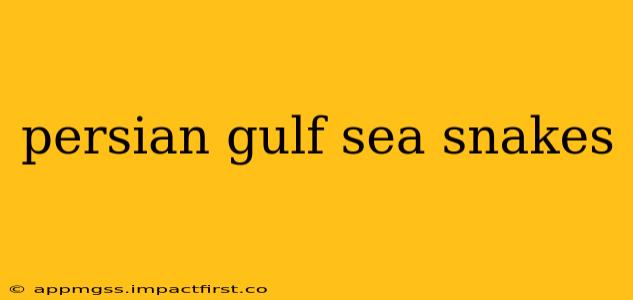The Persian Gulf, a vital waterway teeming with diverse marine life, is also home to a fascinating array of sea snakes. These serpentine creatures, often misunderstood and feared, play a crucial role in the Gulf's delicate ecosystem. This comprehensive guide delves into the world of Persian Gulf sea snakes, exploring their species, behavior, venom, and conservation status.
What types of sea snakes live in the Persian Gulf?
The Persian Gulf boasts a variety of sea snake species, though precise numbers are difficult to ascertain due to ongoing research and the challenges of studying these elusive creatures. Some of the most commonly encountered species include members of the Hydrophiinae subfamily, known for their fully aquatic lifestyles. Specific identification often requires expert analysis, and many sightings are reported as simply "sea snake" without precise species designation. However, research continues to shed light on the specific populations inhabiting the region.
Are Persian Gulf sea snakes venomous?
Yes, many sea snakes found in the Persian Gulf are venomous. However, it's crucial to understand that they are not inherently aggressive. Most sea snake bites occur when humans accidentally handle or step on them. Their venom, while potent, is often less toxic to humans than that of some land snakes, though still capable of causing serious harm. The severity of a bite depends on factors such as the species of snake, the amount of venom injected, and the victim's health. Immediate medical attention is always necessary following a sea snake bite.
How dangerous are Persian Gulf sea snakes to humans?
While venomous, Persian Gulf sea snakes generally pose a low risk to humans. Their bites are infrequent, largely due to their generally docile nature. They are not typically aggressive and tend to avoid contact with humans. However, accidental encounters, such as while swimming, diving, or fishing, can lead to bites. Respecting their space and avoiding unnecessary handling are key to minimizing the risk.
What is the conservation status of sea snakes in the Persian Gulf?
The conservation status of sea snakes in the Persian Gulf is a concern. Habitat degradation, pollution, and fishing practices pose significant threats to these populations. Climate change and its impact on sea temperature and salinity also add to the challenges these animals face. Specific conservation efforts focused on sea snakes in the Persian Gulf are limited, highlighting the need for increased research and protective measures.
What is the diet of Persian Gulf sea snakes?
Persian Gulf sea snakes are primarily piscivorous, meaning their diet consists largely of fish. They are adept hunters, using their venom to subdue their prey. The specific fish species they target varies depending on the sea snake species and the availability of prey in their habitat. Their diet contributes to the balance of the marine ecosystem, helping to control fish populations.
What are the threats to Persian Gulf sea snakes?
Several threats impact the survival of Persian Gulf sea snakes:
- Habitat Loss and Degradation: Coastal development, pollution, and destruction of seagrass beds significantly affect their habitat.
- Fishing Activities: Bycatch (unintentional capture) in fishing nets is a significant threat.
- Climate Change: Rising sea temperatures and changes in salinity can disrupt their habitat and affect their survival.
- Pollution: Chemical pollutants and plastic debris in the water contaminate their environment and potentially impact their health.
How can we protect Persian Gulf sea snakes?
Protecting Persian Gulf sea snakes requires a multifaceted approach:
- Marine Protected Areas: Establishing and effectively managing marine protected areas to safeguard their critical habitats.
- Reducing Pollution: Implementing stricter regulations to reduce pollution from industrial and agricultural sources.
- Sustainable Fishing Practices: Promoting sustainable fishing methods to minimize bycatch.
- Climate Change Mitigation: Addressing climate change at a global level to lessen its impact on marine ecosystems.
- Research and Monitoring: Continued research to better understand their populations, distribution, and conservation needs.
The Persian Gulf sea snakes are a fascinating and vital part of the region's marine biodiversity. By understanding their behavior, threats, and the importance of their conservation, we can contribute to protecting these unique creatures and preserving the delicate balance of the Gulf's ecosystem. Further research and collaborative conservation efforts are vital to ensuring their long-term survival.
